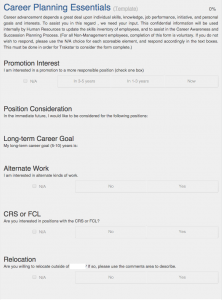4 Elements on the Best Staff and Employee Appraisal Forms (Template)
Posted by Julie • December 2, 2014 (Last modified August 22, 2018) • 3 min read
Wondering how to make staff and employee appraisal forms? After seeing hundreds of appraisal forms from hundreds of customers, we’re boldly declaring there are 4 elements that make up the very best ones.
The best staff and employee appraisals contain these four template elements:
- Competencies
- Goals
- Narrative Questions
- Employee Survey
The first three are familiar. But, what’s #4, an employee survey? It’s a unique section on an appraisal form. It’s chance to ask employees how they are feeling about certain elements of their job or the workplace. Surveys are gaining momentum on appraisal forms, and there’s a reason why. They increase employee participation, provide great data for managers, and responses facilitate a natural, 2-way conversation at the appraisal meeting.
Use competencies.
Competencies are critical on appraisal forms. A core set of competencies are fair. Everyone gets them. They provide great baseline data for all employees and communicate core values. Competencies are the “standardized benchmark” of employment. With them, it’s easy to see which employees are outperforming the curve and which employees are not.
We’ve seen customers select anywhere from 3-60 competencies, with the average quantity around ten. I’d make a case that less is more, and recommend 5 or fewer. Why so few? Competencies tend to cross over. More than five and the definitions of 2 or more become similar. Choose large umbrella competencies. Not sure which ones to pick? Check our report of the 10 most popular competencies, and cut it in half.
Have a Goals section.
Goals acknowledge that employees are doing more than Teamwork, Attendance, and Communication (for example.) I think it’s best when both managers and employees can add goals to the appraisal. This allows for more ownership by the employees. That’s a good thing. I know I want to write some of my own and definitely contribute to ones my manager might add, don’t you? If you don’t allow employees to add goals (if only managers are allowed), consider the reasons why and see if it’s possible to open things up.
Ask questions.
Not everything can be quantified with a rating scale. Narrative questions aren’t rated, and they provide great places for feedback from both managers and employees. Not sure which questions to ask? Check out our list of 16 Great Appraisal Questions. We recommend (2) narrative questions on an appraisal. Can you add three? Sure. But stay away from the “essay” test.
Include an Employee Survey
What’s an employee survey? Here’s an example. It’s a special section on an appraisal form. Answers are not averaged in the final score. The benefit is, these questions are mathematically quantifiable: for example, ask two departments this question:
My current skills are adequate for this job a.) I need to learn more b.) I’m comfortable with my skills c.) I’m really good at this
Perhaps one department responds primarily with “I’m comfortable” and “I’m good” while another responds with a higher quantity of “I need to learn more.” Use the feedback to guide your time and money when training.
Organizations that have used surveys have reported great results. Employees feel heard. Appraisal conversations contain natural conversation starters. Organizations can quantify sentiments.
Here’s an example of a great survey with any revealing information redacted. Great job, anonymous!
**While our blog content is generally of general interest, it is worth noting that a survey is possible within Trakstar as a separate component, done outside outside of the Appraisal on a separate form. It can also be anonymous using the Multi-rater feature.
Do carefully consider any questions you may wish to ask. For example, some questions would be benign combined with the appraisal. But, some questions might be better asked if the respondent is anonymous.
Image credit: Jeff_Golden
Don't Miss Out on More Great HR Articles!
Subscribe to get the latest, greatest HR and Talent Development content straight to your inbox.



